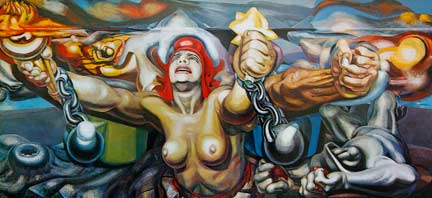The Big Three
Country: Mexico
Time Period: 1920-1950 Mexican Muralism
Diego Rivera was born on December 8, 1886 in Guanajuato, Mexico. Rivera utilized government grants and scholarships to formally study art in Mexico and in Europe. Rivera returned to Mexico in 1921 after meeting David Alfaro Siqueiros, to work on commissions as well from the Mexican government (Britannica). Flattley explains The History of Mexico as, "In an overwhelming and crowded composition, Rivera represents pivotal scenes from the history of the modern nation-state, including scenes from the Spanish Conquest, the fight for independence from Spain, the Mexican-American war, the Mexican Revolution, and an imagined future Mexico in which a workers’ revolution has triumphed". This mural is an extensive and intricate telling of Mexico's history. The North Wall is titled, "The Aztec World", West Wall is titled, "From the Conquest to 1930", and the South Wall is titled, "Mexico Today and Tomorrow" (Flattley). This mural caught my attention due the the extreme detail that was put into the piece. Rivera includes historical figures and deities along with the everyday citizens in all areas of history to tell the history of Mexico but also how it related to the lower working class. Throughout the piece, you can see the indigenous people are representing in a dark rich brown tone as shown primary on the North wall, however as the viewer makes their way to the west wall, a majority of the figures are shown in a paler complexation and above indigenous peoples of Mexico. It is showing all invasions and conquests that have ravished their lands done by the invaders who are strategically placed in a higher position in the painting than the indigenous, representing the struggles the people of Mexico endured. Even as Rivera worked into the South Wall, he is representing the struggles of the working class but represents the idea that there is a brighter future by painting his soon-to-be wife, Frida Kahlo, in the painting wearing a red start necklace with school children who are being educated post revolution (Flattley).
The Art Story Contributors. “David Alfaro Siqueiros, Mexican Painter and Muralist.” The Art Story, 22 Nov. 2016, www.theartstory.org/artist/siqueiros-david-alfaro/#:~:text=1945-,New%20Democracy,at%20the%20end%20of%20WWII.
The Art Story Contributors. “José Clemente Orozco Paintings, Bio, Ideas.” The Art Story, 11 July 2016, www.theartstory.org/artist/orozco-jose-clemente/.
Bravo, Dr. Doris Maria-Reina. “Mexican Muralism: Los Tres Grandes-David Alfaro Siqueiros, Diego Rivera, and José Clemente Orozco.” Smarthistory, 9 Aug. 2015, smarthistory.org/mexican-muralism-los-tres-grandes-david-alfaro-siqueiros-diego-rivera-and-jose-clemente-orozco/.
The Editors of Encyclopaedia. “Diego Rivera.” Encyclopædia Britannica, 13 Apr. 2023, www.britannica.com/biography/Diego-Rivera.
Flattley, Megan. “The History of Mexico: Diego Rivera’s Murals at the National Palace.” Smarthistory, 22 Sept. 2020, smarthistory.org/mexico-diego-rivera-murals-national-palace/.
History.com Editors. “Mexican Revolution.” HISTORY, 10 June 2019, www.history.com/topics/latin-america/mexican-revolution.








I like these pieces. Mexican art is very original. The pieces are full and very detailed and I feel like there is a lot to cover and explore. West Wall stands out for me because of how grandiose it is. IT is a great mix of many colors and personas.
ReplyDelete